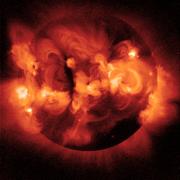Stellar Corona
Surveys of the X-ray sky by the Einstein satellite in the late 1970's established normal stars as copious sources of X-rays. In the case of late-type stars like the Sun, X-rays are produced by a "corona" - a multi-million degree plasma confined by magnetic fields generated in the stellar interior and brought to the surface by their own buoyancy.
We use data from satellites observing from UV to X-rays to study the high energy physics of stars. The range of these studies is vast. Star and planet formation, the evolution of planetary atmospheres, magnetic dynamo processes at work in stellar interiors, the angular momentum evolution of stars, and the origin and acceleration of stellar winds and mass loss are all manifest in, or dependent on, the processes at work in the multi-million degree X-ray emitting outer atmospheres and winds of stars.
High energy phenomena in non-degenerate stars and protostars also offer prototypical examples of plasma and processes that occur on much larger scales in the more distant cosmic X-ray sources---from magnetic reconnection and flares illuminating accretion disks of black holes in active galactic nuclei to X-ray binaries, to the radiatively-driven winds and outflows of these accretion disks, to the hot and tenuous optically-thin plasma of galactic interstellar media and clusters of galaxies. Paradoxically, stars also present us with one of the greatest unsolved problems of modern astrophysics: the heating mechanism of stellar coronae.
Jeremy Drake, Nancy Evans, Vinay Kashyap, Magarita Karovska, Steve Saar, Brad Wargelin




